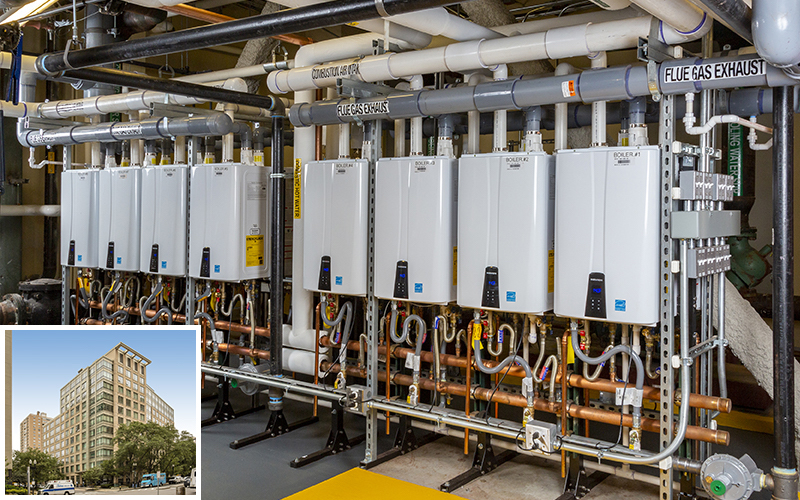There are many options to consider when designing or replacing the domestic hot water systems for a structure or development. But what to use? Tanks or tankless and do I use one for each individual occupied space or a common system?
The first thing that needs to be decided is are the tenant units on individual utilities or one common gas and water service? This would quickly decide the requirement of which route to take with a unit needed to service the individual housing units or a common system serving the entire structure. But wait, it is not necessarily that easy. Perhaps the building shares common utilities but has no common or mechanical space therefore requires the hot water appliance to be located closer or inside the housing units. Location is also a key factor regarding efficient hot water delivery as well as access for service and they need to be located in an appropriate space that meets local codes.
Choosing the type of water heating appliances(s) can seem confusing. There are so many choices as the title indicates but keeping it simple it really comes down to 3 choices: tank(s) (residential or commercial), boiler(s) with storage tank(s) and tankless water heaters. All the options will perform the task however, there are upsides and downsides to many. Commercial tanks and boilers and tanks can be an expensive proposition, as many today have concerns of costs, affording the space and life-expectancy concerns. I think most of us has had a few occasions of leaking or prematurely failed hot water tanks and expenses incurred as well as tenant complaints of no or inconsistent hot water.
TANKLESS WATER HEATERS - A CONSISTENT SUPPLY OF HOT WATER
Tankless water heaters are quickly becoming the go-to appliance for its capability of providing an endless source of consistent temperature of hot water in a vast number of applications, especially multi-family housing. These attributes as well as potentially offering the highest system efficiencies available today within domestic hot water systems is making them the obvious choice. Ideal for multi-family properties, they can be installed individually in each tenant unit or in multiples as a cascaded system staging the correct number of tankless units in operation to meet the hot water demands. Multiple tankless systems offer the redundancy to assure that if a tankless is down for service or has an issue, the hot water demand continues to be met by the remaining units in the system. Imagine no more lack of hot water calls for your management team and maintenance, always at the worst times!
Taking effect January 1, 2009, residential/light commercial gas tankless water heaters which carry the ENERGY STAR® label must have a minimum EF of 0.82, minimum gallons-per-minute flow of 2.5 at a 77 degrees Fahrenheit rise, or be 41.4 percent more efficient than the current Federal standard. A whole-home gas tankless water heater with a 0.82 EF is expected to achieve a 30 percent reduction in energy use and save a consumer approximately $108 in annual energy costs compared to a typical gas storage water heater. This mandate did the entire industry a favor. It essentially removed all tankless products that were for sale and operated at a lower efficiency from the market, which tended to be the units that gave the tankless water heating industry in general the black eyes.
Close to that date and implementation of raised minimum efficiency and standards to tankless also occurred a significant change in the tankless industry. This was the development and improvement of a new class of offerings by many manufacturers, the condensing high-efficiency tankless units. These units typically operate in the .92-.99 EF (Energy Factor)/.91-.97 UEF (Uniform Energy Factor) range. What that means is now we can experience energy savings above and beyond the standard .82 efficiency with upwards of a savings of 45% over conventional domestic water heating systems.
A new efficiency rating system replacing the old also appeared that helped all of us decision makers and users. The Uniform Energy Factor or UEF was implemented on June 12, 2017, by the Department of Energy (DOE). This defined a uniform standard for measuring energy efficiency performance against other brands and types of hot water systems. This is important as now a fair and consistent method and rating is offered to allow easier and more accurate comparisons of systems and appliances as you are making your evaluations and choices regarding efficiencies.
KEY FACTORS TO CONSIDER IN CHOOSING WATER HEATING SYSTEMS FOR APARTMENT BUILDINGS
Today tankless unit choices over conventional systems offer the utmost selections for the application and your budget, non-condensing or condensing. But which way should you go? It really depends on application, location, budget and installation requirements. Non-condensing is often chosen for simplistic individual operation, a favorite in the south for its often-outdoor installation. Condensing high efficiency is the common go to for its efficiencies, ease of cascading multiple units for high demand hot water capacities in multi family units as well as its often-simplistic common flue gas exhaust venting.
Tankless units, their offerings as well as accessories can provide a full gamut of multi-family, light commercial applications. From retrofit to new construction and light duty to substantial hot water production, tankless water heater systems can be trusted to perform the job.
Brian Fenske (brian.fenske@navien.com) is Director of Commercial Sales for Navien, Inc.
Navien, the leader in condensing technology, makes it easy to go tankless for commercial and residential applications. To learn more about Navien’s line of tankless water heaters and boilers, visit NavienInc.com.






